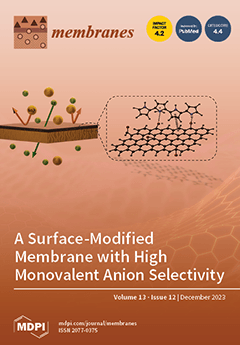Membrane technology has been embraced as a feasible and suitable substitute for conventional time- and energy-intensive biodiesel synthesis processes. It is ecofriendly, easier to run and regulate, and requires less energy than conventional approaches, with excellent stability. Therefore, the present study involved the synthesis and application of a highly reactive and recyclable Titania-based heterogeneous nanocatalyst (TiO
2) for biodiesel production from nonedible
Azadhiracta indica seed oil via a membrane reactor, since
Azadhiracta indica is easily and widely accessible and has a rich oil content (39%
w/
w). The high free fatty acids content (6.52 mg/g KOH) of the nonedible oil was decreased to less than 1% via two-step esterification. Following the esterification, transesterification was performed using a heterogeneous TiO
2 nanocatalyst under optimum conditions, such as a 9:1 methanol–oil molar ratio, 90 °C reaction temperature, 2 wt.% catalyst loading, and an agitation rate of 600 rpm, and the biodiesel yield was optimized through response surface methodology (RSM).
Azadhiracta indica seed oil contains 68.98% unsaturated (61.01% oleic acid, 8.97% linoleic acid) and 31.02% saturated fatty acids (15.91% palmitic acid, 15.11% stearic acid). These fatty acids transformed into respective methyl esters, with a total yield up to 95% achieved. The biodiesel was analyzed via advanced characterization techniques like gas chromatography–mass spectrometry (GC-MS), Fourier transform infrared spectroscopy (FT-IR), and nuclear magnetic resonance (NMR), whereas the catalyst was characterized via X-ray diffraction (XRD), scanning electron microscopy (SEM), energy-dispersive X-ray (EDX), and Fourier transform infrared spectroscopy (FT-IR). Due to its physicochemical properties,
Azadirachta indica seed oil is a highly recommended feedstock for biodiesel production. Moreover, it is concluded that the Titania-based heterogeneous nanocatalyst (TiO
2) is effective for high-quality liquid fuel synthesis from nonedible
Azadirachta indica seed oil in a membrane reactor, which could be an optional green route to cleaner production of bioenergy, eventually leading to sustenance, robustness, and resilience that will aid in developing a holistic framework for integrated waste management.
Full article






